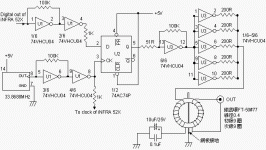Solution to metastability issues:
Use the other flip-flop(FF) that you have on that IC.
Connect the Q output of the first FF to the D input of the second.
Take the Q output of the second FF and use this as the output.
Connect your clock signal to the clock input on both of the FF's.
This is a standard anti-metastability circuit.
Jim.
Use the other flip-flop(FF) that you have on that IC.
Connect the Q output of the first FF to the D input of the second.
Take the Q output of the second FF and use this as the output.
Connect your clock signal to the clock input on both of the FF's.
This is a standard anti-metastability circuit.
Jim.
It is interesting to see that meta-stability and the standard cure
against it seems to be quite well-known. When I worked with
digital design professionally almost 20 years ago it was a
largely unknown phenomenon. I remeber learning about it
from an AMD TTL databook/app.note/whatever which described
the phenomenon and claimed that AMD flip-flop were less
susceptible to this by having a much narrower time window
during which the input must not change.
Of course, coping with meta-stability is necessary in these
applications.
against it seems to be quite well-known. When I worked with
digital design professionally almost 20 years ago it was a
largely unknown phenomenon. I remeber learning about it
from an AMD TTL databook/app.note/whatever which described
the phenomenon and claimed that AMD flip-flop were less
susceptible to this by having a much narrower time window
during which the input must not change.
Of course, coping with meta-stability is necessary in these
applications.
- Status
- Not open for further replies.
